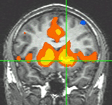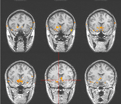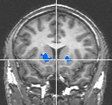| 





|
READING LIST
Please
Note: Due to the proliferation of neuroeconomics literature
in 2005, I will no longer be updating this reading list.
Please use Pubmed
for further research. Academic
Review Articles:
•
Camerer C, Loewenstein, G., Prelec, D. "Neuroeconomics: How Neuroscience
Can Inform Economics" SSRN working paper. In forthcoming Journal of Economics
Perspectives. Here
at SSRN.
•Glimcher
P. &Rustichini A. "Neuroeconomics: The Consilience of Brain and Decision."
Science 2004 306: 447-452.
Year
2005 (as of June):
•
Lane, S.D., Cherek, D.R., Tcheremissine,
O.V., Lieving, L.M. & Pietras, C.J. (2005) Acute marijuana effects on human
risk taking. Neuropsychopharmacology (online
pdf).
•
Gonzalez
et al. (2005). "The framing effect and risky decisions: Examining cognitive
functions with fMRI" Journal of Economic Psychology (online at ScienceDirect).
•
Knutson,
B. & Cooper, J. C. (2005). Functional magnetic resonance imaging of reward
prediction. Current Opinion in Neurology, 18, 411-417.
•
Knutson,
B., Taylor, J., Kaufman, M., Peterson, R., & Glover, G. (2005). Distributed
neural representation of expected value. Journal of Neuroscience, 25, 4806-4812.
•
Knutson,
B. & Peterson, R. (2005). Neurally reconstructing expected utility. Games
and Economic Behavior. July, 2005. pdf.
•
Knutson,
B. & Adcock, R. A. (2005). Remembrance of rewards past. Neuron, 45, 331-332.
•
Gilbert
AM, Fiez JA. Integrating rewards and cognition in the frontal cortex. Cogn Affect
Behav Neurosci. 2004 Dec;4(4):540-52.
•
King-Casas
B, Tomlin D, Anen C, Camerer CF, Quartz SR, Montague PR. Getting to know you:
reputation and trust in a two-person economic exchange. Science. 2005 Apr 1;308(5718):78-83.
•
Miller
G.Neuroscience. Economic game shows how the brain builds trust. Science. 2005
Apr 1;308(5718):36.
•
Yarkoni
T, Gray JR, Chrastil ER, Barch DM, Green L, Braver TS. Sustained neural activity
associated with cognitive control during temporally extended decision making.
Brain Res Cogn Brain Res. 2005 Apr;23(1):71-84.
•
Cohen
MX, Heller AS, Ranganath C. Functional connectivity with anterior cingulate and
orbitofrontal cortices during decision-making. Brain Res Cogn Brain Res. 2005
Apr;23(1):61-70.
•
Ursu
S, Carter CS. Outcome representations, counterfactual comparisons and the human
orbitofrontal cortex: implications for neuroimaging studies of decision-making.
Brain Res Cogn Brain Res. 2005 Apr;23(1):51-60.
•
Hare TA, Tottenham N, Davidson MC, Glover GH, Casey BJ. Contributions of amygdala
and striatal activity in emotion regulation. Biol Psychiatry. 2005 Mar 15;57(6):624-32.
•
Wittmann
BC, Schott BH, Guderian S, Frey JU, Heinze HJ, Duzel E. Reward-related FMRI activation
of dopaminergic midbrain is associated with enhanced hippocampus-dependent long-term
memory formation. Neuron. 2005 Feb 3;45(3):459-67.
•
Knutson B, Adcock RA. Remembrance of rewards past. Neuron. 2005 Feb 3;45(3):331-2.
•
Delgado
MR, Miller MM, Inati S, Phelps EA. An fMRI study of reward-related probability
learning. Neuroimage. 2005 Feb 1;24(3):862-73. Epub 2004 Nov 18.
•
Reuter J, Raedler T, Rose M, Hand I, Glascher J, Buchel C. Links Pathological
gambling is linked to reduced activation of the mesolimbic reward system. Nat
Neurosci. 2005 Feb;8(2):147-8. Epub 2005 Jan 9.
•
Eagleman DM. Comment on "The involvement of the orbitofrontal cortex in the
experience of regret". Science. 2005 May 27;308(5726):1260.
•
Fishbein
DH, Eldreth DL, Hyde C, Matochik JA, London ED, Contoreggi C, Kurian V, Kimes
AS, Breeden A, Grant S. Risky decision making and the anterior cingulate cortex
in abstinent drug abusers and nonusers. Brain Res Cogn Brain Res. 2005 Apr;23(1):119-36.
•
Levine
B, Black SE, Cheung G, Campbell A, O'Toole C, Schwartz ML. Gambling task performance
in traumatic brain injury: relationships to injury severity, atrophy, lesion location,
and cognitive and psychosocial outcome. Cogn Behav Neurol. 2005 Mar;18(1):45-54.
•
Brand M, Labudda K, Kalbe E, Hilker R, Emmans D, Fuchs G, Kessler J,
Markowitsch
HJ. Decision-making impairments in patients with Parkinson's disease. Behav Neurol.
2004;15(3-4):77-85.
•
Brand
M, Kalbe E, Labudda K, Fujiwara E, Kessler J, Markowitsch HJ. Related Decision-making
impairments in patients with pathological gambling. Psychiatry Res. 2005 Jan 30;133(1):91-9.
•
Jollant
F, Bellivier F, Leboyer M, Astruc B, Torres S, Verdier R, Castelnau
D, Malafosse
A, Courtet P. Impaired decision making in suicide attempters. Am J Psychiatry.
2005 Feb;162(2):304-10.
•
Spinella M, Lester D, Yang B. Gambling and delaying rewards as a function of frontal
system dysfunction: a study in neuroeconomics. Percept Mot Skills. 2004 Dec;99(3
Pt 1):993-4.
•
Reuter J, Raedler T, Rose M, Hand I, Glascher J, Buchel C. Links Pathological
gambling is linked to reduced activation of the mesolimbic reward system. Nat
Neurosci. 2005 Feb;8(2):147-8. Epub 2005 Jan 9.
•
Fukui
H, Murai T, Fukuyama H, Hayashi T, Hanakawa T. Functional activity related to
risk anticipation during performance of the Iowa Gambling Task. Neuroimage. 2005
Jan 1;24(1):253-9.
•
Shurman
B, Horan WP, Nuechterlein KH. Schizophrenia patients demonstrate a distinctive
pattern of decision-making impairment on the Iowa Gambling Task.
Schizophr
Res. 2005 Jan 1;72(2-3):215-24.
•
Martin
CO, Denburg NL, Tranel D, Granner MA, Bechara A.The effects of vagus nerve stimulation
on decision-making. Cortex. 2004 Sep-Dec;40(4-5):605-12.
•
Paulus
MP, Feinstein JS, Castillo G, Simmons AN, Stein MB. Dose-dependent decrease of
activation in bilateral amygdala and insula by lorazepam during emotion processing.
Arch Gen Psychiatry. 2005 Mar;62(3):282-8.
•
Wright
P, He G, Shapira NA, Goodman WK, Liu Y. Disgust and the insula: fMRI responses
to pictures of mutilation and contamination. Neuroreport. 2004 Oct 25;15(15):2347-51.
•
Simmons
A, Matthews SC, Stein MB, Paulus MP. Anticipation of emotionally aversive visual
stimuli activates right insula. Neuroreport. 2004 Oct 5;15(14):2261-5.
Year 2004:
• de
Quervain DJ, Fischbacher U, Treyer V, Schellhammer M, Schnyder U, Buck A, Fehr
E. "The neural basis of altruistic punishment." Science 305, 1254 (2004).
• Knutson
B. "Behavior. Sweet revenge?" Science. 2004 Aug 27;305(5688):1254-8.
• Lane,
SD, Cherek, DR, Pietras, CJ, & Tcheremissine, OV (2004). Alcohol effects on
human risk taking. Psychopharmacology, 172, 68-77.
• Matthews
SC, Simmons AN, Lane SD, Paulus MP (2004). Selective activation of the nucleus
accumbens during risk-taking decision making. Neuroreport, 15, 2123-2127.
•
Samuel M. McClure,1,2
Jian Li,1 Damon Tomlin, Kim S. Cypert, Latane´ M. Montague, and P. Read
Montague. "Neural Correlates of Behavioral Preference for Culturally Familiar
Drinks." Neuron, Vol. 44, 379-387, October 14, 2004.
•
Hornak J, O'Doherty J, Bramham J, Rolls ET, Morris RG, Bullock PR, Polkey CE.
"Reward-related reversal learning after surgical excisions in orbito-frontal
or dorsolateral prefrontal cortex in humans." J Cogn Neurosci. 2004 Apr;16(3):463-78.
•
Terrence R. Chorvat
, Kevin McCabe and Vernon Smith. "Law & Neuroeconomics." SSRN working
paper.
•
Colin Camerer , George
Loewenstein and Drazen Prelec. "Neuroeconomics: Why Economics Needs Brains."
Scandinavian Journal of Economics, Vol. 106, No. 3, pp. 555-579, September 2004.
•
Paul J. Zak. "Neuroeconomics."
Philosophical Transactions of the Royal Society Biology, Forthcoming. Now on SSRN.
•
Walter H (2004) "Neurophilosophical
perspectives on conservative compatibilism." In Schramme T, Thome J (eds)
Philosophy and Psychiatry. de Gruyter, pp. 283-294.
•
Walter et al. (2004)
"Understanding intentions in social interaction: The role of the anterior
paracingulate cortex." Journal of Cognitive Neuroscience, im Druck.
•
Rilling JK, Sanfey AG, Aronson JA, Nystrom LE, Cohen JD. Opposing BOLD responses
to reciprocated and unreciprocated altruism in putative reward pathways. Neuroreport.
2004 Nov 15;15(16):2539-43.
•
Davidson MC, Horvitz JC, Tottenham N, Fossella JA, Watts R, Ulug AM, Casey
BJ. Differential cingulate and caudate activation following unexpected nonrewarding
stimuli. Neuroimage. 2004 Nov;23(3):1039-45.
•
Ramnani
N, Elliott R, Athwal BS, Passingham RE. Prediction error for free monetary reward
in the human prefrontal cortex. Neuroimage. 2004 Nov;23(3):777-86.
•
Ullsperger
M, von Cramon DY.Neuroimaging of performance monitoring: error detection and beyond.
Cortex. 2004 Sep-Dec;40(4-5):593-604.
•
McClure SM, Laibson DI, Loewenstein G, Cohen JD. Separate neural systems value
immediate and delayed monetary rewards. Science. 2004 Oct 15;306(5695):503-7.
•
Lane SD, Cherek DR, Pietras CJ, Steinberg JL, Performance of Heavy Marijuana-smoking
Adolescents on a Laboratory Measure of Motivation. Addictive Behaviors. 30(4):815-28.
May 2005.
•
Lane SD,Tcheremissine, OV,Lieving, LM,Nouvion, SO,Cherek, DR, Acute Effects of
Alprazolam on Risky Decision Making in Humans. Psychopharmacology. Apr 2005.
•
Lane
SD,Cherek DR,Tcheremissine OV,Lieving LM,Pietras CJ, Acute Marijuana Effects on
Human Risk Taking. Neuropsychopharmacology : Official Publication of the American
College of Neuropsychopharmacology. 30(4):800-9. Apr 2005.
•
Lane
SD,Cherek DR,Lieving LM,Tcheremissine OV,Marijuana Effects on Human Forgetting
Functions. Journal of the Experimental Analysis of Behavior. 83(1):67-83. Jan
2005.
•
Matthews
SC,Simmons AN,Lane SD,Paulus MP,Selective Activation of the Nucleus Accumbens
During Risk-taking Decision Making. Neuroreport. 15(13):2123-7. Sep 2004.
•
Lane
SD,Cherek DR,Pietras CJ,Tcheremissine OV, Alcohol Effects on Human Risk Taking.
Psychopharmacology. 172(1):68-77. Feb 2004.
Years 1995-2003
Popular Press:
•A
recent New
York Times article on Neuromarketing. •Blakeslee,
S. “Brain experts now follow the money.”
New York Times, June 17, 2003. •Peterson, R. (2003). Probing the brain
of an investor: How advances in neuroscience
are demystifying the markets. html. •Postrel, V. (2003). “Looking inside
the brains of the stingy.” New York Times,
February 23, 2003. •Wells,
M. (2003). "In Search of the Buy Button" (c) 09.01.03 Forbes.com.
html.
•Zweig,
J. (2002) “Are you wired for wealth?”
Money Magazine. October, 2002. Academic
Neuroscience: •Camerer,
C., Loewenstein, G., & Prelec, D. (2003).
Neuroeconomics: How neuroscience
can inform economics. pdf •Glimcher,
P. (2003). Decisions, uncertainty, and the brain: The science of neuroeconomics.
Cambridge, MA: MIT Press. •Peterson,
R. Book review of Decisions, Uncertainty,
and the Brain: The science of neuroeconomics.
html.
•Special
Review Issue on Reward and Decision. (2002). Neuron, (36)2.
•Paulus
MP, Rogalsky C, Simmons A, Feinstein JS, Stein MB. Increased activation in the
right insula during risk-taking decision making is related to harm avoidance and
neuroticism. Neuroimage. 2003 Aug;19(4):1439-48.
•Grafman,
J., 2002, in The Frontal Lobes (eds. D. Stuss and R. Knight) pp. 292-310, oxford
U.K: Oxford University Press.
•Wood,
Jacqueline, and Jordan Grafman, 2003. Human prefrontal cortex: Processing and
representational perspectives. Nature Reviews Neuroscience, 4, pp. 139-147.J.
D.
•Cohen,
M. Botvinick, C. S. Carter. 2000. Anterior cingulate and prefrontal cortex: who's
in control? Nature Neuroscience 3, 421 - 423.
•John
G. Kerns, Jonathan D. Cohen, Angus W. MacDonald III, Raymond Y. Cho, V. Andrew
Stenger, Cameron S. Carter. 2004. Anterior Cingulate Conflict Monitoring and Adjustments
in Control. Science 303, 1023-1026.
•Frith,
C.D. and Frith, U. (1999) "Interacting minds - a biological basis."
Science 286, 1692-1695
•Gallagher
Helen L., and Christopher D. Frith (2003), "Functional imaging of 'theory
of mind'," TRENDS in Cognitive Sciences, Vol.7 No.2, pp. 77 - 83.
•McCabe,
Kevin, D. Houser, L. Ryan, Vernon Smith, and T. Trouard. 2001. "A Functional
Imaging Study of 'Theory of Mind' in Two-Person Reciprocal Exchange." Proceedings
of the National Academy of Sciences 98, pp. 11832-11835.
•Rilling,
James, David Gutman, Thorsten Zeh, Giuseppe Pagnoni, Greogory Berns, Clinton Kilts,
2002. A neural basis for cooperation. Neuron, 35, pp. 395-405.
•Gallagher,
H.L., et. al., 2002. Imaging the intentional stance. NeuroImage, 16, pp. 814-821.
•Sanfey,
Alan, James Rilling, Jessica Aronson, Leigh Nystrom, and Jonathan Cohen, 2003.
The neural basis of economic decision making in the Ultimatum Game, Science, June
2003.
•Glimcher,
Paul, (2002). Decisions, Decisions, Decisions: Choosing a Biological Science of
Choice, Neuron, 36, pp. 323-332.
•Schultz,
Wolfram, (2000). Multiple Reward Signals in the Brain. Nature Reviews Neuroscience,
1, pp. 189-207
•Schultz,
Wolfram, Peter Dayan, and Read Montague, "A Neural Substrate of Prediction
and Reward," Science, 1997(275), pp. 1593-1599.
•Fiorillo,
Christopher, Philippe Tobler, Wolfram Schultz, 2003. Discrete coding of reward
probability and uncertainty by dopamine neurons. Science, 299, pp. 1898-1902.
•Shizgal,
Peter, and Andreas Arvanitogiannis, 2003. Gambling on dopamine. Science, 299,
pp. 1856-1858.
•Shizgal,
Peter. "Neural basis of utility estimation," Current Opinions in Neurobiology,
1997, 7(2), 198-208.
•Shigzal,
Peter, "On the neural computation of utility: implications from studies of
brain stimulation reward," in D. Kahneman, E. Diener & N. Schwartz, Eds.
Well-Being: The Foundations of Hedonic Psychology, New York: Russell Sage Foundation,
1999, pp. 502-526.
•Montague,
Reed, and Gregory Berns (2002). Neural Economics and the Biological Substrates
of Valuation, Neuron, 36, pp. 265-284
•Engelman,
D.L., C Person, and R. Montague (1998). A computational role for dopamine delivery
in human decision-making. Journal of Cognitive Neuroscience, 10, pp. 623-630.
•Berns,
G.S., McClure, S.M., Pagnoni, G. and Montague, P.R.. Predictability modulates
human brain response to reward. Journal of Neuroscience, 21, pp. 2793-2798.
•Tremblay,
L. & Schultz, W.,1999. Relative reward preference in primate orbitofrontal
cortex, Nature 398, 704-708.
•Platt,
Michael and Paul W. Glimcher, 1999. Neural correlates of decision variables in
parietal cortex, Nature, 400, pp. 233-238.
•Thut,
Gregor, Wolfram Schultz, Ulrich Roelcke, Matthias Nienhusmeier, John Missimer,
Paul Maguire, and Klaus Leenders, (1997). Activation of the human brain by monetary
reward, NeuroReport, 8, pp. 1225-1228.
•Knutson,
Brian, Andrew Westdorp, Erica Kaiser, and Daniel Hommer, (2000). FMRI Visualization
of Brain Activity during a Monetary Incentive Delay Task," NeuroImage, 12,
pp. 20-27.
•Knutson,
B., Adams, C. M., Fong, G. W., & Hommer, D. (2001). Anticipation of increasing
monetary reward selectively recruits nucleus accumbens. Journal of Neuroscience,
21(RC159), 1-5.
•Knutson,
B., Fong, G. W., Adams, C. M., Varner, J. L., & Hommer, D. (2001). Dissociation
of reward anticipation and outcome with event-related FMRI. NeuroReport, 12, 3683-3687.
•Breiter,
H. C., Aharon, I., Kahneman, D., Dale, A., & Shizgal, P, 2001, "Functional
imaging of neural responses to expectancy and experience of monetary gains and
losses," Neuron, 30, pp. 619-639.
•Bechara,
Antoine, Hanna Damasio, Daniel Tranel, Antonio Damascio, " Deciding Advantageously
Before Knowing the Advantageous Startegy," Science, 1997(275), pp. 1293-1295.
•Damasio,
A. R., D. Tranel, and H. Damasio, 1991. Somatic markers and the guidance of behavior:
Theory and preliminary testing. In H.S. Levine, H.M. Eisenberg, A.L. Benton, eds.,
Frontal Lobe Function and Dysfunction (pp. 217-229). New York: Oxford University
Press.
•O'Doherty
J., M. Kringelbach, E. Rolls, and C. Andrews, 2001. Abstract reward and punishment
representations in the human orbitofrontal cortex. Nature Neuroscience, (4)1,
pp. 95-102.
•Smith,
Kip, John Dickhaut, Kevin McCabe, and Jose Pardo, (2002). Neuronal Substrates
for Choice under Ambiguity, Risk, Gains, and Losses, Management Science, 48, pp.
711-718.
•Goel,
Vinod, Jordan Grafman, Jinous Tajik, Sheldon Gana, and David Danto, "A study
of the performance of patients with frontal lobe lesions in a financial planning
task," Brain, 1997(120), pp. 1805-1822. •Barraclough
DJ, Conroy ML, Lee D (2004) Prefrontal cortex and decision making in a mixed-strategy
game. Nature Neurosci. 7: 404-410.
•LeDoux,
Joseph, Synaptic Self, Penguin Books, New York, New York. 2002. •Walter
et al. (2003) Content, context and cognitive style in mood-memory interactions.
TICS 7: 433-4.
•Erk
et al. (2002). Functional Neuroimaging of depression. In: Kaschka WP (ed) Perspectives
in Affective Disorders. Karger, Basel, S.. 63-69
•Erk et al. (2003) Emotional context modulates subsequent memory
effect. Neuroimage 18: 439-447
•Erk
et al. (2002) Cultural objects modulate reward circuitry. Neuroreport 13:2499-2503.
Academic
Economics:
•Camerer,
Colin. (2003). Behavioral
Game Theory. Princeton University Press.
•McCabe,
Kevin. 2002. Neuroeconomics. Encyclopedia of Cognitive Science, Lynn Nadel ed.,
Nature Publishing Group.
•Gigerenzer,
Gerd, and Reinhard Selten. Bounded Rationality: The Adaptive Toolbox. Massachusetts
Institute of Technology Press, London England, 2001.
•Smith,
Vernon (2000), Bargaining and market behavior : essays in experimental economics.
Cambridge, Cambridge University Press.
•Robson,
Arthur, (2001). The Biological Basis of Economic Behavior, Journal of Economic
Literature, 34, pp. 11-31.
•Kahneman,
Daniel; Wakker, Peter P. and Sarin, Rakesh. "Back to Bentham? Explorations
of Experienced Utility." Quarterly Journal of Economics, May 1997, 112(2),
pp. 375-405. Press, 2000.
•Friedman,
M. and J. Savage, 1984. The utility analysis of choices involving risks. The Journal
of Political Economy, 56, pp. 279-304.
•Dickhaut,
John, Kevin McCabe, Jennifer Nagode, Kip Smith, and Jose Pardo, 2003. The role
of context in choice: The effect of different comparison gambles on risky behavior,
Proceedings of the National Academy of Sciences, (100)2003, pp. 3536-3541.[50]
•Kaplan,
Hillard S. and Hill, Kim,1985. Food-Sharing Among Ache Foragers: Tests of Explanatory
Hypotheses." Current Anthropology, 26(2), pp. 223-45.
•Kaplan,
Hillard S. and Robson, Arthur J, 2003. The Evolution of Human Life Expectancy
and Intelligence in Hunter-Gatherer Economies. American Economic Review, 93(1),
pp. 150-169.
•de
Waal, Frans. 1997. "The Chimpanzee's Service Economy: Food for Grooming."
Evolution and Human Behavior 18(6): 375-86.
•Brosnan,
Sarah, and Frans de Waal. 2003. Monkeys Reject Unequal Pay. Nature. 425, pp. 297-299.
Academic
Psychology:
•Dolan,
R., (2002). Emotion, Cognition, and Behavior, Science, 298, pp. 1191-1194.
•Tversky,
A. and Kahneman, D., 1986. Rational choice and the framing of decisions. The Journal
of Buisness, 59, pp 251-278.
•Metcalfe,
J. and Mischel, W. "A Hot/Cool-System analysis of Delay of Gratification:
Dynamics of Willpower," Psychological Review 106, No. 1 (1999), 3-19.
Academic
Marketing: •Zaltman,
Gerald. 2003. How Customers Think: Essential insights into the mind of the
market. Harvard Business School Press, Boston, USA. |
